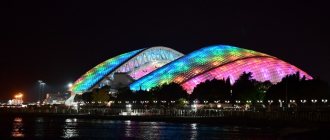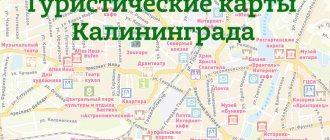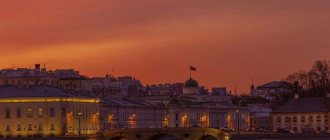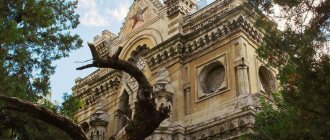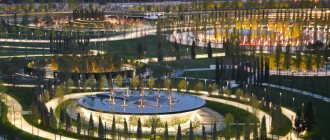> Countries Russia St. Petersburg
Pushkin is one of the most picturesque suburbs of St. Petersburg. Historical and architectural monuments of the 18th century and residential buildings of the 19th century are well preserved here. It includes the famous Tsarskoe Selo museum-reserve with picturesque parks, luxurious palaces and unusual pavilions. This is a great travel destination where you can see the center in one day, as well as admire nature or immerse yourself in the rich history of these places.
- In the center
- Neighborhood
- Excursions
- Map
List of attractions
Catherine Park
The main Pushkin park was designed by the best masters of landscape gardening on the orders of Catherine I. Subsequently, the residence became one of the favorite vacation spots of the imperial family. In addition to the famous Catherine Palace, there are many interesting things to see in the alleys: elegant Baroque pavilions, the Admiralty complex, memorial monuments in honor of victories in the Russian-Turkish wars, sculptures, neo-Gothic buildings, unusual bridges, observation platforms, alleys and canals. Entrance is paid and costs 150 rubles; the price does not include a visit to the palace. A card will be issued along with the ticket.
Grand Catherine Palace
The majestic Baroque palace was built according to Rastrelli's design. Both the façade and the interiors are richly decorated, including the famous Amber Room, which took six tons of amber to create. The residence was the favorite place of three empresses: Catherine I, Elizaveta Petrovna and Catherine II.
After the revolution, the palace faced a difficult fate: at first, many valuables were sold, and during the war, most of the interiors were destroyed. Among other things, the Amber Room was stolen, the location of which still remains unknown. Now the palace has been completely restored and brought back to its original appearance, the Amber Room has been recreated. Entrance is 700 rubles, it is better to go with a guided tour.
Address: Sadovaya st., 7
Hermitage Pavilion
The pavilion was created specifically for Elizabeth Petrovna, and it was here that the empress received people close to her. “Hermitage” means “hermit’s hut” and, like the pavilion of the same name in Peterhof, serves as a place of solitude and meetings with selected guests. The baroque ornate façade resembles a smaller version of the Winter Palace, and indeed, the same architect, Rastrelli, worked on it.
Inside, the pavilion was equipped with a special mechanism: when receiving guests for a feast, the tables were raised from under the floor, and after dinner they were lowered back and made room for dancing. The mechanism is still demonstrated as part of the excursion.
Cameron Gallery
The Cameron Gallery is a two-story complex ensemble, which includes a gallery, a ramp, a Hanging Garden and Cold Baths. It was built according to ancient models in the 18th century, and on the second floor there are busts of philosophers and emperors of the Ancient World, whose works influenced Catherine 2. The Hanging Garden, where fruit trees and flowers grew, has also been preserved - one of the oldest in Russia. Later, a ramp was also built, since the empress did not like stairs.
Hermitage kitchen
The neo-Gothic kitchen was built by order of Catherine II and served as a place for receiving guests and an additional entrance to the park. The unplastered brick walls are reminiscent of Gothic buildings in England, and the simple but elegant decor of the facade already belongs to the elements of classicism. Now there is a restaurant of the same name inside.
Tower Ruin
The unusual structure was conceived as a semblance of a Turkish fortress left in ruins. The tower is one of many memorial monuments dedicated to victories in the Russian-Turkish wars. There are similar ruins in Orlovsky Park in Strelna and in Tsaritsyno, all of them were built at the same time, when there was a fashion for such aesthetics. Artificial cracks and ruins were created, which created certain difficulties during restoration - after all, it is necessary to repair the building, but preserve the appearance of ruins.
You can climb the tower; from the observation deck you will have a view of the park. Free admission.
Turkish bath
The Turkish bath was also created in memory of the victory in the Russian-Turkish War of 1829, and the hammam bath in Adrianaple was taken as a model. Interior details were brought as trophies from this Turkish city. From the outside, the bathhouse resembles a mosque with a minaret, and inside there were niches with water of different temperatures. The ornate Moorish-style interior was restored during the restoration, so it's definitely worth stopping by. Entrance to the pavilion is purchased separately.
Admiralty
On the shore of the Big Pond is the Admiralty complex, where imperial ships formerly stood. The collection of sailing and rowing vessels was collected from different countries, including gondolas, trashcoats, caiques and pirogues. The collection was lost during the war, but the architectural complex of the Admiralty was partially preserved and was restored. The neo-Gothic red brick buildings are reminiscent of European castles with crenellated parapets, spiers and distinctive window shapes. Now there is a restaurant here.
Gothic gate
The cast iron Gothic gates are modeled after English Gothic. At the time of its creation, it was a unique cast-iron foundry work: few places in the world could cast such large-scale projects, because the weight of the gate was 30 tons. The supports feature female figures, and the columns are connected by a graceful arch.
Chesme Column
The memorial monument is dedicated to the victory in the Russian-Turkish war in 1774. The rostral column designed by Rinaldi also resembles the pillar in Rome, erected in honor of the victory over Carthage. The eagle symbolizes triumph, and the pond symbolizes Chesma Bay, where the battle took place. The column is connected by a tunnel to the ruined tower.
Alexandrovsky Park
Like Catherine Park, Alexander Park is named after the ruler for whom it was created. Alexander I designed the park for himself and personally monitored the progress of the work. The result was a landscaped English park with many curious structures, pavilions and architectural whims. Free admission.
Alexander Palace
The main attraction of the park is the majestic Alexander Palace. Initially it was called New Tsarskoye Selo and was built specifically for the wedding of Alexander I according to Quarenghi’s design. This is a classic palace in a classical style in the form of a semi-rotunda with two side wings and elaborate rich interiors.
Alexander I and all subsequent emperors preferred other palaces, with the exception of Nicholas II, who loved the Alexander Palace. Guests were received here and the 300th anniversary of the Romanov dynasty was celebrated. Later, it was here that the family of Nicholas II was arrested, after which they were sent into exile.
During World War II, Pushkin was occupied. The palace was occupied by German troops, and a cemetery was located in the adjacent territory.
For a long time the palace was dilapidated, but recently it was completely restored. Recreated interiors are now available to visitors: 13 halls, including the apartments of Nicholas II and Alexandra Feodorovna.
Address: Palace street, 2
Chinese village
The park has a very unusual complex of buildings - the Chinese Village. Construction of the village began under Catherine II and became a tribute to the fashion for Chinese architecture and art that spread throughout Europe. It is noteworthy that the initial designs were recreated from engravings. In the 19th century, Chinese pagodas were rented out as apartments; for some time Karamzin lived in one of the houses. Some of them are still rented out. In addition to the pagodas, the Dragon Bridge and the Great Chinese Bridge are also interesting.
Pushkin parks are truly unique from an architectural point of view. They reflect several fashion trends at once: neo-Gothic semi-ruined towers or Chinese pagodas.
History of Tsarskoye Selo
The settlement was founded in 1710. This part of the land was conquered by Peter I from the Swedes and donated to A.D. Menshikov, and he, in turn, gave it to his wife, Ekaterina Alekseevna. Palace servants began to build their houses here. The improvement was in full swing. The first modest palace was created. In the 1740-1750s, Empress Elizaveta Petrovna moved here. She is renovating the grounds into a luxurious summer residence.
@pushkin.online
During the reign of Catherine the Great, construction was prohibited in the park area; for this purpose, the Sofia district was established nearby, where everyone lived except the royal family. In 1808, the village was connected to Sofia, officially creating a city. Here, for the first time in Russia, a railway for passengers was built. They built the best lyceum in the country at that time. In 1887, the site became the first in Europe to be fully electrified. The Alexander Palace was the main and last residence of Nicholas II and his family. During the Soviet years, the place was renamed first to the Uritsky Children's Village, and then to Pushkin. Most of the buildings housed children's institutions. During the war, all buildings were badly damaged, many works of art were stolen. But restoration began immediately. A number of museums have been opened and are now protected at the state level. To this day, restoration work continues.
@pushkin.online
Neighborhood
Kazan Cemetery
The main Pushkin cemetery, Kazanskoye, is located a 40-minute walk from the center. Those who died during the First World War, public figures, famous residents of the city, the poet Annensky and actor Ilya Oleinikov are buried here.
Pavlovsk
Next door is another royal residence with an impressive palace and park ensemble, built by order of Paul I. Here it is pleasant to walk through the neat park, see historical churches or visit the abandoned officer barracks.
How to get to the city of Pushkin
There are several types of transport from St. Petersburg to the city. Distance – 25 km in a straight line. Travel time depends on where you start your journey: from the center it will be longer, and from the outskirts it will be twice as fast. So, by train from Vitebsky station you will get there in 30 minutes. The interval of routes is every 10-20 minutes. By train from the Kupchino railway station the trip will take only 15 minutes.
The second way to get there is by buses and minibuses. From the Moskovskaya metro station on routes No. 187, K-545, K-287, K-347a and K-342. From “Kupchino” No. K-545a, K-286, K-342 and K-347. From "Zvezdnaya" No. 186, 179 and K-363.
To travel by car, set the GPS coordinates of your destination - 59.717612, 30.406233, and move along Vitebsky Prospect, and then Petersburg Highway. Any city taxi can also take you there.
Opening hours of the Catherine Palace in Pushkin
The museum is open from 10:00 to 18:00, visitors can enter until 17:00.
Closed on Tuesday and every last Monday of the month.
As a rule, the museum is closed from December 31 to January 1. December 28 and 29 are working days.
Catherine and Alexander bets are open daily from 7:00 to 21:00.
Ecology of the area
In general, the environmental background of the Pushkinsky district is one of the most prosperous in the Northern capital: the small amount of industry located here has an effect. However, those enterprises that are located, for example, in Shushary, are not harmful, so they do not cause any particular damage to the environment.
There are many nature reserves in the region that are under state protection. In this regard, a rather strict environmental policy is being pursued here, the purpose of which is to preserve the cultural heritage located in Pushkin, Pavlovsk and other municipal divisions of the region. In this regard, almost all indicators are normal: the air is little polluted, the soil too, background radiation is normal, and the noise level exceeds the permissible level only in the vicinity of small industrial zones and near highways.
There are problems in the water: the Slavyanka River flowing in the Pushkinsky district, from the point of view of environmentalists, is quite dirty. Recent studies by the international organization Greenpeace show the content of heavy metals, mercury, petroleum products, chloroform and other toxic and harmful chemical compounds in the river water. This is explained by the fact that many unscrupulous industries often dump waste from their activities there.
Central square and garden
In addition to parks in Pushkin, two public gardens located in the historical center of the city are especially popular:
— Cathedral Square with Catherine’s Cathedral;
— Lyceum Garden with a monument to A.S. Pushkin and the small Znamenskaya Church.

